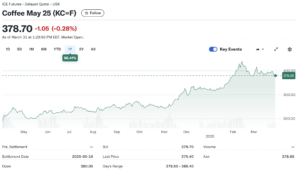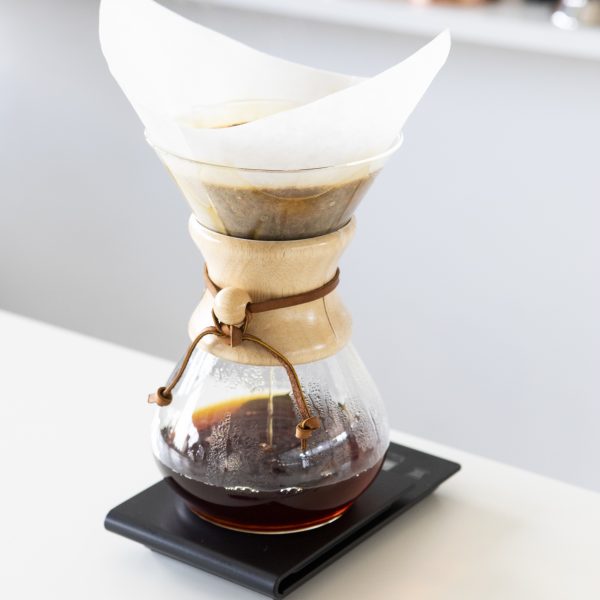Blog

Understanding the C market: How green coffee prices are determined and why they fluctuate
Blog:
The coffee industry is one of the most dynamic and complex commodity markets in the world, with coffee prices experiencing often unpredictable fluctuations. For coffee producers, traders, and even consumers, understanding the factors that drive green coffee prices is really important. At the heart of this pricing mechanism lies the “C market,” which is the global benchmark for Arabica coffee prices.
The “C market” refers to the coffee futures market, specifically for Arabica coffee, which is traded on the Intercontinental Exchange (ICE) in New York. Futures contracts are agreements to buy or sell a commodity, like coffee, at a predetermined price on a future date. The C market sets the global benchmark price for Arabica coffee, the most widely consumed coffee species in the world.
Here’s how it works with an example: imagine you own a café, and you want to make sure you can buy coffee at a good price for the next year. On the C market, you could agree to buy coffee at a fixed price in advance, even if you don’t actually need it until then. This is called a “futures contract” – it’s like reserving coffee at today’s price, to be delivered on a set date in the future.
Arabica coffee prices on the C market are influenced by a range of factors, including supply and demand, weather conditions, geopolitical events, and market speculation. The price set on the C market is the base price for green coffee beans, to which other factors like quality, origin, and transportation costs are added.
While the C market specifically deals with Arabica coffee, Robusta coffee is traded separately on the London International Financial Futures and Options Exchange (LIFFE). Although the mechanisms are similar, Robusta prices are generally lower than Arabica due to differences in flavor, growing conditions, and production costs.
Let’s analyze how those factors can affect the price of the green coffee:
Weather conditions: coffee production is highly sensitive to weather. Arabica coffee, in particular, requires specific conditions like mild temperatures, heavy rainfall and high altitudes. Unfavorable weather, such as droughts, frosts, or excessive rainfall, can significantly reduce yields, causing supply shortages and driving up prices. For example, the 2021 frost in Brazil, the world’s largest coffee producer, severely damaged coffee crops, leading to a sharp increase in Arabica prices.
Production levels: countries like Brazil, Vietnam, Colombia, and Ethiopia are major coffee producers. Any significant changes in production levels due to factors like labor shortages, political instability, or pests can impact the global supply, and consequently influence prices. For example, let’s talk about Vietnam in 2020. Vietnam, which is the world’s largest producer of Robusta coffee, because of a combination of heavy rains, labor shortages, and logistical challenges due to the COVID-19 pandemic reduced Robusta offer. As a result, Robusta prices on the London market increased by around 15% during that year.
Harvest cycles: coffee trees have a bi-annual production cycle, with alternating years of high and low production. This natural cycle can cause fluctuations in supply, which in turn affects prices.
There are also several factors due to the market demand:
Global consumption trends: the demand for coffee continues to rise, driven by growing consumption in traditional markets like the U.S. and Europe, as well as emerging markets in Asia and Africa. An increase in demand without a corresponding increase in supply can push prices higher.
Consumer preferences: the growing popularity of specialty coffee has led to a higher demand for premium Arabica beans, which can drive up prices for specific types of coffee. This trend towards higher-quality coffee also influences lower-grade coffee price dynamics.
As well as the market speculation:
Traders and Investors: speculation in the futures market can cause significant price fluctuations. Traders buy and sell coffee contracts based on predictions about future supply and demand. If investors believe that a future event (e.g., extreme weather conditions, political instability) will reduce supply, they may buy contracts, driving up prices even before the event occurs.
Currency Fluctuations: coffee is traded globally, but prices are often quoted in U.S. dollars (the C market is based in New York). Therefore, fluctuations in exchange rates can impact coffee prices. For example, if the Brazilian real weakens against the dollar, Brazilian coffee becomes cheaper for international buyers, potentially increasing demand and driving up prices on the C market.
Lastly, there are geopolitical factors that can alter coffee prices on the stock market:
Political instability in coffee-producing countries can make production and exports difficult, leading to supply shortages. Additionally, trade policies, tariffs, and sanctions can all influence coffee prices.
The futures market plays a crucial role in determining coffee prices. Futures contracts allow producers, exporters, and traders to hedge against price volatility by locking in prices for future delivery. This can provide some stability in a market that is otherwise highly unpredictable.
For example, if a coffee producer in Brazil is concerned about the potential impact of future weather events, they might sell futures contracts to guarantee a specific price for their coffee, regardless of what happens in the market. On the other hand, a coffee roaster might buy futures contracts to secure a steady supply of coffee at a known price, protecting themselves against sudden price increases.
The futures market can also influence prices through speculation. If traders believe that an event (such as a drought or political unrest) will reduce future supply, they might buy large numbers of futures contracts, driving up prices even before the event occurs. This speculative activity can lead to price swings that may not always reflect the current supply and demand balance.
So, what does the future hold for coffee prices?
Looking ahead, several factors could shape the future of coffee prices: as climate change continues to impact traditional coffee-growing regions, we may see more frequent lacks in supply, leading to increased price volatility. Producers may need to adapt by cultivating more resilient coffee varieties or shifting production to new regions.
In the meanwhile, consumers’ demand for ethically sourced and environmentally sustainable coffee is rapidly increasing, impacting prices particularly for premium Arabica beans. For this reason certifications (like Fair Trade and Rainforest Alliance) may become more important, potentially leading to higher prices for certified coffees.
In the last decade, we’ve been experiencing a rapid increase in coffee consumption in emerging markets like China and India and demand may exceed supply, putting upward pressure on prices.
This increased demand could also lead to more investment in coffee production, both in traditional growing regions and new areas bringing innovation in coffee cultivation, processing, and trading could help stabilize prices by improving efficiency and reducing risks. For example, better weather forecasting, pest management, and supply chain transparency could help mitigate some of the factors that currently cause price fluctuations.
To conclude, the world of coffee pricing is a complex and ever-changing field, guided by a combination of supply and demand factors, market speculation, and unpredictable events. Understanding the C market and how green coffee prices are determined can help coffee producers, traders, and consumers to understand better the coffee industry. Whether you’re a coffee farmer, a trader, or just someone who loves their daily brew, staying informed about these trends can help you make better decisions and appreciate the global journey of coffee from farm to cup.



